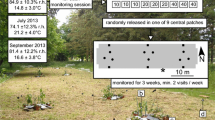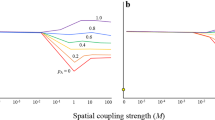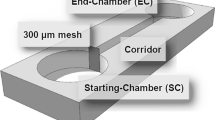Summary
A simulation model has been used to investigate the influence of animal (insect) distribution and dispersal among exhaustable resource units (food plants). Population size and stability were used as measures of success. The results showed that population size and stability are highest when egg batch size is as large as can be supported by the average food plant or slightly larger if larval dispersal occurs. Clumping of egg batches of food plants increases population stability when egg batches are small by insuring that some food plants will not be overcrowded. Increasing the proportion of larval dispersers or the success of dispersers can increase or decrease population size and stability depending on the original egg batch distribution, but individuals which produce offspring some of which disperse, generally have a selective advantage. Density dependent larval dispersal decreases population stability. Finally, individuals with lower reproductive capacities can have a selective advantage over those with higher reproductive capacities under certain conditions of egg batch size and larval dispersal.
Similar content being viewed by others
References
Birch, L.C.: The role of environmental heterogeneity and genetical heterogeneity in determining distribution and abundance. In: Dynamics of populations-Proceedings of the advanced study institute on “Dynamics of numbers in populations” (P.J. den Boer, G.R. Gradwell, eds.), pp. 109–128. Wageningen: Centre for Agricultural Publishing and Documentation 1971
den Boer, P.J.: On the significance of dispersal power for populations of carabid-beetles (Coleoptera, carabidae). Oecologia (Berl.) 4, 1–28 (1970)
Brower, L.P.: Experimental analysis of egg cannibalism in the Monarch and Queen butterflies, Danaus plexippus and D. gilippus berenice. Physiol. Zool. 34, 287–296 (1961)
Ford, E.B.: Butterflies. London: Collins 1962
Gadgil, M.: Dispersal: population consequences and evolution. Ecology 52, 253–260 (1971)
Gilbert, L.E.: Pollen feeding and reproductive biology of Heliconius butterflies. Proc. nat. Acad. Sci. (Wash.) 69, 1403–1407 (1972)
Green, W.Q.: An antagonistic insect/host-plant system: the problem of persistence. Ph.D. Thesis, Department of Zoology, University of British Columbia, 247 p. (1974)
Gruys, P.: Growth in Bupalus piniarius (Lepidoptera: Geometridae) in relation to larval population density. Agric. Res. Rep., 127 p. Wageningen: Pudoc 1970
Harcourt, D.G.: Design of a sampling plan for studies on the population dynamics of the diamond back moth, Plutella maculipennis (Curt.) (Lepidoptera: Plutellidae). Canad. Ent. 93, 820–831 (1961a)
Harcourt, D.G.: Spatial pattern of the imported cabbageworm, Pieris rapae (L.) (Lepidoptera: Pieridae), on cultivated Cruciferae. Canad. Ent. 93, 945–952 (1961b)
Harcourt, D.G.: Spatial pattern of the cabbage looper, Trichoplusia ni, on Crucifers. Ann. ent. Soc. Amer. 58, 89–94 (1965)
Kulman, H.M.: Oviposition habits of Trichogramma minutum on artificial concentrations of eggs of European pine shoot moth. Ann. ent. Soc. Amer. 58, 241–243 (1965)
Labine, P.A.: The population biology of the butterfly, Euphydryas editha. VIII. Oviposition and its relation to patterns of oviposition in other butterflies. Evolution 22, 799–805 (1968)
Levins, R.: Extinction. In: Mathematics in biology. Amer. Math. Soc. 2, 77–107 (1970)
Monro, J.: The exploitation and conservation of resources by populations of insects. J. anim. Ecol. 36, 531–547 (1967)
Morris, F.: The dynamics of epidemic spruce budworm populations. Mem. entomol. Soc. Canada No. 31, 332 p. (1963)
Myers, J.H., Campbell, B.J.: Distribution and dispersal in populations capable of resource depletion. A field study on Cinnabar moth. Oecologia (Berl.) 24 (in press, 1976)
Reddingius, J., den Boer, P.J.: Simulation experiments illustrating stabilization of animal numbers by spreading of risk. Oecologia (Berl.) 5, 240–284 (1970)
Roff, D.A.: Spatial heterogeneity and the persistence of populations. Oecologia (Berl.) 15, 245–258 (1974a)
Roff, D.A.: The analysis of a population model demonstrating the importance of dispersal in a heterogeneous environment. Oecologia (Berl.) 15, 259–275 (1974b)
Roff, D.A.: Population stability and the evolution of dispersal in a heterogeneous environment. Oecologia (Berl.) 19, 217–238 (1975)
Southwood, T.R.E.: Ecological methods. London: Chapman and Hall 1966
Van Valen, L.: Group selection and the evolution of dispersal. Evolution 25, 591–598 (1971)
Watt, K.E.F.: Comments on fluctuations of animal populations and measures of community stability. Canad. Ent. 96, 1434–1442 (1964)
Author information
Authors and Affiliations
Rights and permissions
About this article
Cite this article
Myers, J.H. Distribution and dispersal in populations capable of resource depletion. Oecologia 23, 255–269 (1976). https://doi.org/10.1007/BF00345956
Received:
Issue Date:
DOI: https://doi.org/10.1007/BF00345956




